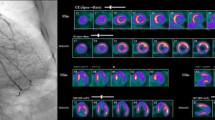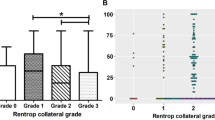Summary
Although a functional role of coronary collaterals has been continuously debated, we observed the following facts in our studies during intracoronary thrombolytic therapy: (a) Myocardial ischemia is important for the development of collateral circulation, (b) collaterals can perfuse the infarcted myocardium, and (c) the presence of collaterals prevents the left ventricular aneurysm formation in acute myocardial infarction, even when the amount of the salvaged tissue is small. Thus, coronary collaterals are not merely markers of severe ischemia but help to preserve the functional integrity of the myocardium in the presence of coronary obstruction. We then attempted to promote collateralization to treat patients with angina pectoris. Patients with chronic stable effort angina were treated with heparin followed by treadmill exercise twice a day for 10 days. Treadmill capacity was found to improve in association with an increase in coronary collateral circulation. Heparin treatment of ischemic patients was found to be a noninvasive alternative to percutaneous transluminal coronary angioplasty and coronary bypass surgery for patients who are not candidates for invasive procedures.
Similar content being viewed by others
References
Schaper W. Tangential wall stress as a molding force in the development of collateral vessels in the canine heart.Experientia 1967;23:595–596.
Yamanishi K, Fujita M, Ohno A, Sasayama S. Importance of myocardial ischaemia for recruitment of coronary collateral circulation in dogs.Cardiovasc Res 1990;24:271–277.
Unger EF, Sheffield CD, Epstein SE. Creation of anastomoses between an extracardiac artery and the coronary circulation.Circulation 1990;82:1449–1466.
Symons JD, Pitsillides KF, Longhurst JC. Chronic reduction of myocardial ischemia does not attenuate coronary collateral development in miniswine.Circulation 1992;86:660–671.
Feldman RL, Pepine CJ. Evaluation of coronary collateral circulation in conscious humans.Am J Cardiol 1984;53:1233–1238.
Cohen M, Rentrop KP. Limitation of myocardial ischemia by collateral circulation during sudden controlled coronary artery occlusion in human subjects: A prospective study.Circulation 1986;74:469–476.
Sasayama S, Fujita M. Recent insights into coronary collateral circulation.Circulation 1992;85:1197–1204.
Fujita M, Sasayama S, Ohno A, Nakajima H, Asanoi H. Importance of angina for development of collateral circulation.Br Heart J 1987;57:139–143.
Fujita M, Sasayama S, Araie E, Ohno A, Yamanishi K, Hirai T. Significance of pre-infarction angina for occurrence of post-infarction angina.Eur Heart J 1988;9:159–164.
Hirai T, Fujita M, Sasayama S, et al. Importance of coronary collateral circulation for kinetics of serum creatine kinase in acute myocardial infarction.Am J Cardiol 1987;60:446–450.
Habib GB, Heibig J, Forman SA, Brown BG, Roberts R, Terrin ML, Bolli R, the TIMI Investigators. Influence of coronary collateral vessels on myocardial infarct size in humans: Results of phase I Thrombolysis in Myocardial Infarction (TIMI) Trial.Circulation 1991;83:739–746.
Reimer KA, Jennings RB. The “wavefront phenomenon” of myocardial ischemic cell death. II. Transmural progression of necrosis within the framework of ischemic bed size (myocardium at risk) and collateral flow.Lab Invest 1979;40:633–644.
Hirai T, Fujita M, Nakajima H, et al. Importance of collateral circulation for prevention of left ventricular aneurysm formation in acute myocardial infarction.Circulation 1989;79:791–796.
Forman MB, Collins HW, Kopelman HA, et al. Determinants of left ventricular aneurysm formation after anterior myocardial infarction: A clinical and angiographic study.J Am Coll Cardiol 1986;8:1256–1262.
Piek JJ, Becker AE. Collateral blood supply to the myocardium at risk in human myocardial infarction: A quantitative postmortem assessment.J Am Coll Cardiol 1988;11:1290–1296.
Shen WF, Cui LQ, Gong LS, Lesbre JP. Beneficial effect of residual flow to the infarct region of left ventricular volume changes after acute myocardial infarction.Am Heart J 1990;119:525–529.
Hochman JS, Choo H. Limitation of myocardial infarct expansion by reperfusion independent of myocardial salvage.Circulation 1987;75:299–306.
Hale SL, Kloner RA. Left ventricular topographic alterations in the completely healed rat infarct caused by early and late coronary artery reperfusion.Am Heart J 1988;116:1508–1513.
Schaper W. Biological and molecular biological aspects of angiogenesis in coronary collateral development. In: Nakamura M, Vanhoutte DM, eds.Coronary Circulation in Physiological and Pathological States. Tokyo: Springer-Verlag, 1991:21–27.
Azizkhan RG, Azizkhan JC, Zetter BR, Folkman J. Mast cell heparin stimulates migration of capillary endothelial cells in vitro.J Exp Med 1980;152:931–944.
Taylor S, Folkman J. Protamine is an inhibitor of angiogenesis.Nature 1982;297:307–312.
Unger EF, Sheffield CD, Epstein SE. Heparin promotes the formation of extracardiac to coronary anastomoses in a canine model.Am J Physiol 1991;260:H1625-H1634.
Banai S, Shou M, Jaklitsch MT, Ferrara N, Epstein SE, Unger EF. Enhancement of coronary collateral blood flow by intracoronary injection of vascular endothelial growth factor.J Am Coll Cardiol 1992;19:191A.
Yanagisawa-Miwa A, Uchida Y, Nakamura F, et al. Salvage of infarcted myocardium by angiogenic action of basic fibroblast growth factor.Science 1992;257:1401–1403.
D'Amore PA, Thompson RW. Collateralization in peripheral vascular disease. In: Strandness DE, Didisheim P, Clowes AW, Watson JT, eds.Vascular Diseases. New York: Grune and Stratton, 1987:319–333.
Fujita M, Mikuniya A, Takahashi M, et al. Acceleration of coronary collateral development by heparin in conscious dogs.Jpn Circ J 1987;51:395–402.
Carroll SM, White FC, Roth DM, Bloor CM. Heparin accelerates coronary collateral development in a porcine model of coronary artery occlusion.Circulation 1993;88:198–207.
Fujita M, Sasayama S, Asanoi H, Nakajima H, Sakai O, Ohno A. Improvement of treadmill capacity and collateral circulation as a result of exercise with heparin pretreatment in patients with effort angina.Circulation 1988;77:1022–1029.
Quyyumi AA, Diodati JG, Lakatos E, Bonow RO, Epstein SE. Angiogenic effects of low molecular weight heparin in patients with stable coronary artery disease: A pilot study.J Am Coll Cardiol 1993;22:635–641.
Fujita M, Yamanishi K, Hirai T, Ohno A, Miwa K, Sasayama S. Comparative effect of herparin treatment with and without strenuous exercise on treadmill capacity in patients with stable effort angina.Am Heart J 1991;122:453–457.
Lehmann KG, Doria RJ, Feuer JM, Hall PX, Hoang DT. Paradoxical increase in restenosis rate with chronic heparin use: Final results of a randomized trial.J Am Coll Cardiol 1991;17:181A.
Author information
Authors and Affiliations
Rights and permissions
About this article
Cite this article
Sasayama, S. Effect of coronary collateral circulation on myocardial ischemia and ventricular dysfunction. Cardiovasc Drug Ther 8 (Suppl 2), 327–334 (1994). https://doi.org/10.1007/BF00877317
Received:
Accepted:
Issue Date:
DOI: https://doi.org/10.1007/BF00877317




